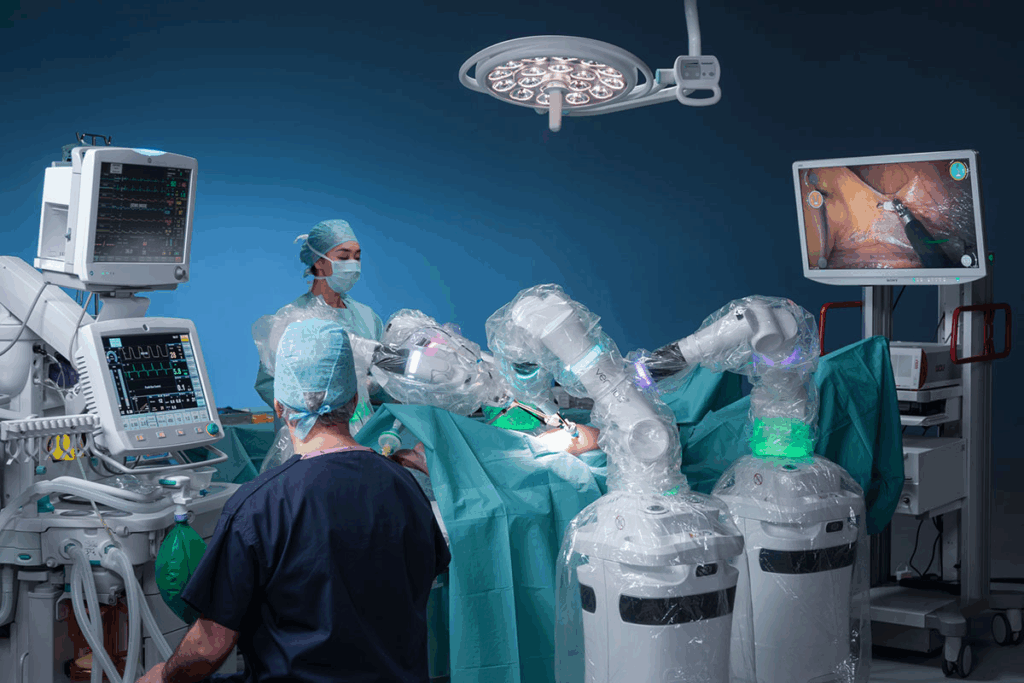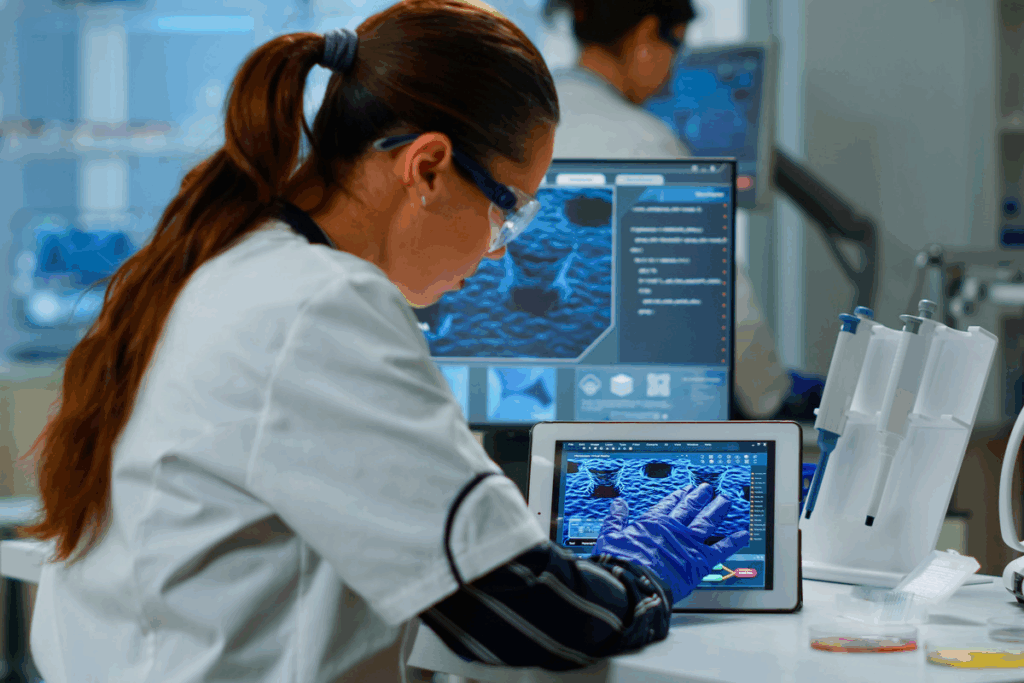Last Updated on November 3, 2025 by mcelik

A hospital started using robotic surgery. This change has made treating complex cases easier. It allows for quicker recovery and discharge times for patients. This move is part of a bigger trend where robotic surgery is becoming more common worldwide. The Prevalence of Robotic Surgery is growing fast. See the crucial statistics showing how common this amazing method is becoming globally.
As robotic surgery adoption rates keep going up, it’s important to know how common it is. This article will look into its current use, benefits, and future trends. It’s key for doctors and patients to understand this.Insurance

Robotic surgery has changed medicine a lot. It brings new precision and flexibility to surgeries. This change comes from years of research and development.
The idea of robotic surgery started in the late 20th century. It was needed for more precise and less invasive surgeries. Early robotic-assisted surgeries were the start of this new era.
Getting from idea to real use was hard. It needed big steps in robotics, computer science, and surgery. These areas came together to make robots that surgeons could control better.
There have been many important moments in robotic surgery’s growth. The da Vinci Surgical System was a big step. Other key points include better tools, improved views, and smarter control systems.
These changes have made robotic surgery better. They’ve also made it useful for more types of surgeries.

In recent years, the United States has seen a big jump in robotic surgery use. This is thanks to its many benefits, like better precision, shorter recovery times, and less invasive procedures.
More and more procedures are being done with robotic surgery every year. Robotic surgery is now common in many hospitals. Surgeons and patients see its benefits over old surgical methods.
Robotic surgery’s adoption rate has been steadily rising. Recent stats show a big jump in robotic surgery procedures in the US. This shows more doctors and patients are embracing robotic technology in surgery.
| Year | Number of Robotic Surgeries | Growth Rate (%) |
| 2015 | 500,000 | 10 |
| 2018 | 750,000 | 15 |
| 2022 | 1,200,000 | 20 |
The table shows robotic surgery procedures have grown a lot over the last ten years. It shows a steady increase in adoption rates.
The growth of robotic surgery shows an accelerating adoption rate. The last decade has seen a big move towards robotic-assisted surgeries. This is thanks to tech improvements and growing trust in its results.
The image shows the rise in robotic surgery use. It shows its growing role in US healthcare.
As robotic surgery keeps improving, it’s likely to become even more common. This will be thanks to new tech and more uses in different surgeries.
Globally, robotic surgery is becoming more common. Countries face different challenges in using this advanced medical tech. The adoption rate varies widely, based on healthcare systems, economic conditions, and laws.
Looking at international markets, we see big differences in robotic surgery adoption. The United States, Germany, and Japan lead, with many procedures done each year.
| Country | Number of Robotic Surgery Procedures (2022) | Market Share (%) |
| United States | 650,000 | 55 |
| Germany | 120,000 | 10 |
| Japan | 100,000 | 8 |
A report by Intuitive Surgical shows the global robotic surgery market is growing. This growth is due to more demand for less invasive surgeries and better robotic tech.
“The future of surgery is robotic. It’s not just about the technology; it’s about improving patient outcomes and making surgery better.”
Emerging markets have big hurdles to overcome in adopting robotic surgery. These include high costs, a lack of skilled surgeons, and poor healthcare systems. Yet, India and China are making progress, investing in tech and training.
Despite these hurdles, emerging markets are key to robotic surgery’s global growth. They are driven by a growing need for advanced medical tech and better healthcare systems.
Robotic surgery is used in different medical fields, but some use it more than others. This depends on the complexity of the procedures, the benefits, and the training available.
Urology was one of the first fields to use robotic surgery. It’s used for procedures like prostatectomies. This technology has made these surgeries more precise and effective.
Gynecology quickly adopted robotic surgery, mainly for hysterectomies and endometriosis treatment. It has less blood loss, less pain, and shorter hospital stays.
Key procedures in gynecologic robotic surgery include:
General surgery also uses robotic procedures, like cholecystectomies and hernia repairs. The robotic method offers better dexterity and visualization, leading to better results.
While urology, gynecology, and general surgery lead in robotic surgery, other fields are exploring it too. Cardiothoracic surgery has seen advancements in robotic-assisted coronary artery bypass grafting. Orthopedic and neurosurgery are starting to use robotic technology, but at a slower pace due to the complexity of their procedures.
The future of robotic surgery across these specialties looks promising. Ongoing research and development aim to expand its use and improve outcomes.
The robotic surgery market is growing fast. This is because of new technologies, more older people, and more chronic diseases needing surgery.
Intuitive Surgical leads the robotic surgery market with its da Vinci system. It’s the top choice for complex surgeries because of its precision and minimal invasiveness. But, new competitors are starting to challenge Intuitive Surgical’s big market share.
The da Vinci system’s success comes from its advanced tech. It has 3D visualization and instruments that feel like the surgeon’s hands. Yet, its high cost and maintenance are barriers for some hospitals.
New players are entering the robotic surgery market. Medtronic, Johnson & Johnson, and CMR Surgical are among them. They offer new features, lower prices, and more flexibility.
These newcomers are pushing for more innovation and lower costs. As the market grows, we’ll see even more advanced robotic surgery systems.
The robotic surgery market is set for big growth. It’s driven by new tech, more demand for less invasive surgeries, and better robotic systems. It will be exciting to see how the big players adapt and innovate in this competitive field.
The use of robotic surgery changes a lot between different hospitals. This change comes from the hospital’s size, location, and if it’s academic or community-based.
Academic hospitals, linked to medical schools, lead in adopting new tech like robotic surgery. They have the resources and space for innovation and training.
Community hospitals, though slower, are starting to use robotic surgery too. They do this because of patient needs, skilled surgeons, and wanting to stay competitive.
| Hospital Type | Adoption Rate (%) | Average Number of Procedures |
| Academic Hospitals | 85 | 250 |
| Community Hospitals | 60 | 150 |
Robotic surgery is not the same in rural and urban areas. Cities have bigger hospitals and more specialist surgeons, making tech like this more available.
Rural places face issues like smaller hospitals, fewer surgeons, and higher costs for robotic systems. This makes care less accessible for rural folks.
To fix these issues, there are training for rural surgeons and efforts to make robotic surgery cheaper and more accessible for smaller hospitals.
Robotic surgery is growing due to many factors. These include better surgical results and making hospitals more competitive. It’s important for those in healthcare to understand these reasons.
Robotic surgery has many benefits. It leads to less blood loss, less pain, and shorter hospital stays. Research shows it has fewer complications and better results than traditional surgery.
A study in the Journal of Urology found robotic prostatectomy has fewer complications than open surgery. This supports robotic surgery’s benefits, making it more popular.
Hospitals use robotic surgery as a marketing tool. It attracts patients looking for the latest in surgery. Having robotic surgery can influence a patient’s choice of hospital.
A table below shows how robotic surgery benefits hospitals:
| Marketing Advantage | Description | Impact |
| Enhanced Reputation | Robotic surgery makes the hospital look innovative. | More patients trust and prefer it. |
| Competitive Edge | Robotic surgery makes the hospital stand out. | It attracts patients wanting advanced surgery. |
| Patient Attraction | Robotic surgery draws patients looking for less invasive options. | More patients for surgical services. |
Surgeons like robotic surgery for its ergonomic benefits. It offers improved dexterity and less fatigue. The design allows for precise movements, making complex procedures easier.
The ergonomic benefits also make surgery more comfortable for surgeons. It can reduce the strain of long surgeries.
Understanding patient demographics is key to addressing disparities in robotic surgery access. Robotic surgery has changed the medical field, bringing benefits like shorter recovery times and less invasive procedures. But, not all patients have equal access to this technology.
Socioeconomic factors greatly affect whether a patient can get robotic surgery. Income level and insurance status are key. Patients with higher incomes and good insurance are more likely to get robotic surgery. On the other hand, those with lower incomes may struggle to access it due to lack of insurance or underinsurance.
Economic disparities also play a role. Studies show that hospitals in minority or low-income areas are less likely to offer robotic surgery. This gap means some patients miss out on its benefits.
The use of robotic surgery in the U.S. shows big differences from place to place. These differences are due to things like how urban an area is and the resources of hospitals. Knowing these differences is key to understanding how robotic surgery affects healthcare.
Robotic surgery isn’t used the same everywhere in the U.S. Some states use it more than others. For example, big cities in states like California, Texas, and Florida use it a lot. This is because they have lots of people and top-notch hospitals.
Looking closer, we see even more differences. For example, cities have more robotic surgery than rural areas. This is because cities have more patients, more money, and better training for doctors.
There’s a big difference in how robotic surgery is used in cities versus rural areas. Cities, with their big hospitals and doctors, are quick to use new tech like robotic surgery. But, rural areas struggle to get this tech because they have fewer resources and less access to training.
“The gap in robotic surgery access between cities and rural areas shows we need to make sure everyone gets the same healthcare,” said a top robotic surgery expert.
To fix this, we’re working on training rural doctors and making robotic surgery cheaper and easier to use. As healthcare changes, it’s important to make sure robotic surgery helps everyone, no matter where they live.
Teaching the next generation of surgeons about robotic surgery is key. As robotic tech grows in operating rooms, we need more skilled surgeons. They must know how to use these systems well.
“The future of surgery is robotic,” says a top robotic surgery expert. “We must train our surgeons well for this field.”
Fellowship programs in robotic surgery are getting more popular. They give surgeons a chance to learn by doing with robotic systems. These programs are for surgeons who have finished their residency and want to specialize in robotic surgery.
These programs cover both theory and practice. Surgeons learn about robotic surgery basics, like choosing patients and caring for them after surgery. They also get to practice by helping and doing surgeries with experienced robotic surgeons.
Simulation and virtual reality (VR) are changing how surgeons train. These tools offer a real-like setting for surgeons to practice without risking patients.
Simulation training lets surgeons practice robotic surgery skills safely. They can work on tasks like stitching and dissecting. VR adds a more immersive experience, mimicking real surgeries.
Benefits of Simulation and VR Training:
As robotic surgery grows, education and training are vital. Fellowship programs, simulation, and VR are key. They help ensure surgeons are ready to give top care to their patients.
Robotic surgery has become more common, and it’s important to look at its results. We need to see if it’s better than other surgeries in helping patients. This helps us know if robotic surgery really improves care.
Studies have shown robotic surgery has its advantages. It often means less blood loss, shorter hospital stays, and less pain for patients. This is true for many types of surgeries.
A study in the Journal of the American Medical Association (JAMA) looked at robotic surgery versus traditional laparoscopic surgery for hysterectomy. It found robotic surgery had fewer complications and shorter hospital stays. But, it also said we need more research because the evidence is not strong enough yet.
| Surgical Outcome | Robotic Surgery | Traditional Surgery |
| Blood Loss | Less | More |
| Hospital Stay | Shorter | Longer |
| Postoperative Pain | Reduced | More |
How happy patients are and their quality of life are key to judging robotic surgery. Studies show patients are often more satisfied with robotic surgery. This is because it’s less invasive, leading to less scarring and faster recovery.
A study in the Journal of Robotic Surgery found robotic prostatectomy patients had better urinary and sexual function than those who had open surgery. They also had better quality of life scores after surgery.
The research shows robotic surgery is good at reducing immediate problems and improving patients’ long-term quality of life. As robotic surgery keeps getting better, we’ll need to keep studying it to understand its full benefits and any downsides.
The world of robotic surgery is about to see big changes. New technologies and how people use them are leading the way. These changes will shape the future of surgery.
New tech is driving robotic surgery forward. Some key advancements include:
These new tools will make robotic surgery more precise and safe. For example, Intuitive Surgical’s da Vinci system is a leader. It’s expected to get even better with more AI.
Robotic surgery tech is getting better, and more doctors will use it. Here’s what’s expected in the next decade:
| Surgical Specialty | Current Adoption Rate | Predicted Adoption Rate (2025-2035) |
| Urology | 40% | 70% |
| Gynecology | 30% | 60% |
| General Surgery | 20% | 50% |
The future of robotic surgery is bright. New tech and more doctors using it will change surgery. Robotic surgery will play a bigger role in healthcare.
The world of surgical robotics is changing fast. It’s making healthcare better with its many benefits. More and more doctors are using this technology.
Robotic surgery is becoming common in the U.S. and around the world. Different types of doctors are starting to use it too.
The growth of robotic surgery comes from its many advantages. It helps patients get better faster and makes surgery easier for doctors. Companies like Intuitive Surgical are always coming up with new ideas.
New companies are also joining the field. This means there are more choices for doctors and patients.
As technology gets better, we’ll see more doctors using it. This could lead to even better care for patients. It’s important for everyone in healthcare to keep up with these changes.
The future of surgical robotics looks bright. It’s going to make surgery safer and more effective. This is good news for everyone involved in healthcare.
Robotic surgery is a modern way to perform surgery. It uses a robotic system to help the surgeon. This method is different because it uses advanced technology like 3D vision and precise tools.
Robotic surgery has many benefits. It can reduce blood loss and pain after surgery. Patients also have shorter hospital stays and recover faster. It allows for more precise work, leading to better results in complex surgeries.
Robotic surgery is becoming more common in the US. Over the last ten years, more hospitals have started using it. Now, a big part of surgeries in the US are done with robots.
Robotic surgery is used in many areas. This includes urology, gynecology, and general surgery. Common procedures are prostate surgeries, hysterectomies, and some colon surgeries.
Intuitive Surgical’s da Vinci system leads the robotic surgery market. But, new competitors are coming up with their own technologies. This competition is expected to bring more innovation and growth.
There are a few challenges. High costs and limited access are big ones. Surgeons also need special training. There are worries about the learning curve and possible complications.
Education and training for robotic surgery are changing. Now, there are fellowship programs and specialized training. Simulation and virtual reality are also being used to improve skills and outcomes.
The future looks promising. New technologies like AI and machine learning are coming. Robotic surgery is also becoming more popular in new markets. There’s a focus on better outcomes, lower costs, and more efficiency.
Studies show robotic surgery can be better in some cases. It offers improved outcomes and patient satisfaction. But, more research is needed to fully understand its benefits.
Subscribe to our e-newsletter to stay informed about the latest innovations in the world of health and exclusive offers!
WhatsApp us